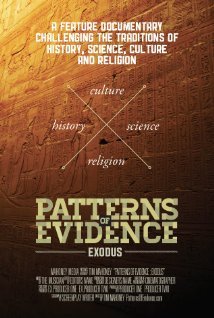“Patterns Leading to Truth and Rational Faith”

| None | Light | Moderate | Heavy | |
|---|---|---|---|---|
| Language | ||||
| Violence | ||||
| Sex | ||||
| Nudity |
What You Need To Know:
In PATTERNS OF EVIDENCE: THE EXODUS, a feature-length documentary, Director Tim Mahoney goes on a quest to find out if the Jews were ever in Egypt, if there ever was a Joseph or a Moses, and if the Jews ever undertook the Exodus. Carefully, Tim refutes some of modern archeology’s straw man arguments to show that the biblical account has great merit. For example, most modern archeologists say the Exodus must have taken place under the Pharaoh Ramses, but that it’s a false myth because there were no plagues, disasters or mass exodus under Ramses. However, Tim shows, with help of renowned archeologists, that there’s evidence for the Hebrew people, the plagues and the Exodus in an earlier stage of Egyptian history.
PATTERNS OF EVIDENCE is beautifully filmed, well photographed and imaginatively illustrated. However, the documentary is not entertainment, but, rather, an educational movie. That doesn’t make it any less important or convincing, but it does make it less entertaining than documentaries designed to be entertaining. PATTERNS OF EVIDENCE is an extremely important documentary that affirms the story of Moses and the Exodus.
Content:
(CCC, BBB) Extremely Christian, biblical, moral worldview refuting false archeology about the Exodus; no foul language; no violence; no sex; no nudity; and, nothing objectionable.
More Detail:
For hundreds of years, the Bible was the primary history book for Western Civilization. Up to the early 1950s, archeology tried to prove the stories in the Bible. Now, the academic world, especially archeology, has changed sides, even when the evidence clearly supports the biblical account. Today’s archeologists and academics are adamantly opposed to recognize the truth of biblical history. Therefore, PATTERNS OF EVIDENCE: THE EXODUS is extremely important.
Director Tim Mahoney goes on a quest in this documentary to find out if the Jews were ever in Egypt, if there ever was a Joseph or a Moses, and if the Jews ever undertook the Exodus. Carefully and methodically, Tim refutes some of modern archeology’s straw man arguments to show that the biblical account has great merit.
For example, most modern archeologists say the Exodus must have taken place under the Pharaoh Ramses, but even so, since it can be shown that there were no plagues, disasters or mass exodus under Ramses, archeologists conclude the Exodus story is a myth. However, Tim shows, with the help of some renowned archeologists, some of whom are agnostics, that there is evidence for Joseph, for the Hebrew people, for the plagues and for the Exodus in an earlier stage of Egyptian history. Thus, below the more modern ruins in Goshen, there are more ancient ruins that clearly show some Semitic or, as the archeologists say, some Canaanite settlers, and these were abandoned suddenly. In fact, there is one home and palace that could easily be identified as Joseph’s, with 12 graves and a pyramid grave with an important ruling Canaanite statue.
Without repeating the information in this documentary movie, it should be noted that the information is so complete and so thorough that several experts changed their position after watching this documentary. That said, this documentary, though beautifully filmed, well photographed and imaginatively illustrated, is not entertainment, but, rather, an educational movie. That doesn’t make it any less important or convincing, but it does make it less entertaining than documentaries designed to be entertaining, such as MARCH OF THE PENGUINS.
It should also be pointed out that many scholars don’t hold to the Ramses theory and do accept the earlier dates for the Hebrew settlement in Egypt, including Professor Thomas Noble from Notre Dame and Professor Bob Brier from Long Island University. Both of these professors are featured in Teaching Company’s Great Courses on the subject of Egypt.
Director Tim Mahoney goes on a quest in this documentary to find out if the Jews were ever in Egypt, if there ever was a Joseph or a Moses, and if the Jews ever undertook the Exodus. Carefully and methodically, Tim refutes some of modern archeology’s straw man arguments to show that the biblical account has great merit.
For example, most modern archeologists say the Exodus must have taken place under the Pharaoh Ramses, but even so, since it can be shown that there were no plagues, disasters or mass exodus under Ramses, archeologists conclude the Exodus story is a myth. However, Tim shows, with the help of some renowned archeologists, some of whom are agnostics, that there is evidence for Joseph, for the Hebrew people, for the plagues and for the Exodus in an earlier stage of Egyptian history. Thus, below the more modern ruins in Goshen, there are more ancient ruins that clearly show some Semitic or, as the archeologists say, some Canaanite settlers, and these were abandoned suddenly. In fact, there is one home and palace that could easily be identified as Joseph’s, with 12 graves and a pyramid grave with an important ruling Canaanite statue.
Without repeating the information in this documentary movie, it should be noted that the information is so complete and so thorough that several experts changed their position after watching this documentary. That said, this documentary, though beautifully filmed, well photographed and imaginatively illustrated, is not entertainment, but, rather, an educational movie. That doesn’t make it any less important or convincing, but it does make it less entertaining than documentaries designed to be entertaining, such as MARCH OF THE PENGUINS.
It should also be pointed out that many scholars don’t hold to the Ramses theory and do accept the earlier dates for the Hebrew settlement in Egypt, including Professor Thomas Noble from Notre Dame and Professor Bob Brier from Long Island University. Both of these professors are featured in Teaching Company’s Great Courses on the subject of Egypt.


 - Content:
- Content: 




